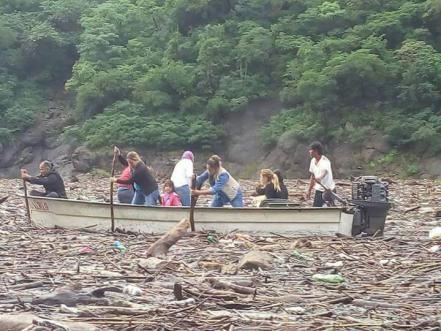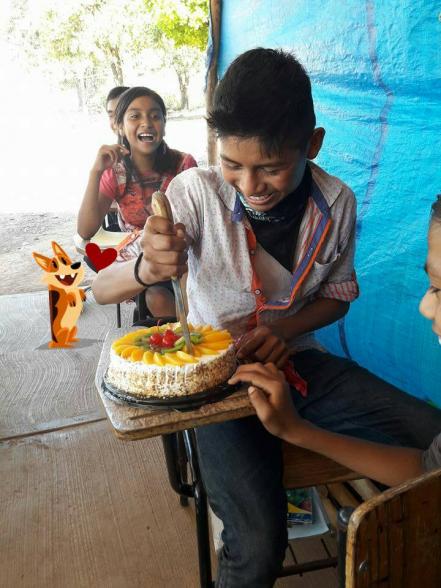English
Huichol student receives birthday cake first time ever
“One has to try to make them happy, regardless of the circumstances.”
An excited Julio cries as he receives his birthday cake from teacher Iris García - Photo taken from Bibi González facebook
Along with other 73 students of Huichol descent , Julio lives in a meager shelter away from his family to pursue junior high-school studies at the distance learning school system known in Mexico as Telesecundaria .

Makeshift classrooms built by the teachers- Photo: Courtesy of Iris García
Here, he takes Monday to Friday classes in a makeshift room made up with tin and cardboard roofs, no walls and two hours away from his native community.
The school shelter “Juan Escutia” is located in the Huaynamota community of the Del Nayar municipality amidst the Nayarit mountain range, home to mostly indigenous Huichol communities. The school was originally equipped with three concrete classrooms, while two additional makeshift spaces where built by the five teachers in charge of running the three-grade junior high school using debris left by the shelter.
Conditions to get to school are hard for both students and teachers, as the latter have to cross a river that is filled with mud and sticks during the rainy season, causing all of them to live in the school’s shelter Monday to Friday, though they may remain there for over 15 days according to existing weather conditions.
Teacher Iris García González, a graduate from the Teacher Training College in Nayarit, runs seventh grade and participated in the construction of the additional makeshift rooms using sheets of cardboard, tarpaulins and timber beams, where her students take classes, as told in an interview with EL UNIVERSAL.
The school shelter “Juan Escutia” is located in the Huaynamota community of the Del Nayar municipality amidst the Nayarit mountain range, home to mostly indigenous Huichol communities. The school was originally equipped with three concrete classrooms, while two additional makeshift spaces where built by the five teachers in charge of running the three-grade junior high school using debris left by the shelter.
Conditions to get to school are hard for both students and teachers, as the latter have to cross a river that is filled with mud and sticks during the rainy season, causing all of them to live in the school’s shelter Monday to Friday, though they may remain there for over 15 days according to existing weather conditions.
Teacher Iris García González, a graduate from the Teacher Training College in Nayarit, runs seventh grade and participated in the construction of the additional makeshift rooms using sheets of cardboard, tarpaulins and timber beams, where her students take classes, as told in an interview with EL UNIVERSAL.

Classrooms built with debris from the shelter - Photos Courtesy of Iris García
“We built the two rooms in the space originally designed for a dinner as it had solid foundations; a sheet of cardboard divides my room from my colleague’s,” she says. The makeshift rooms are equipped with a chalkboard where teacher Iris delivers the entire curriculum, plus some vocabulary in English which she translates to her students into Spanish and the local language, Wixárika.
THE SHELTER
The shelter, where Julio and his classmates live, is only a few minutes from their school and is part of the Indigenous School Shelters Program, ascribed to the National Committee for the Development of Indigenous Peoples (CDI). Around 100-120 students ranging from elementary to high school grades live in the shelter as they come from different Huichol communities. However, “basic services such as drinking water or water for showers is scarce”, says teacher Iris.
The shelter, where Julio and his classmates live, is only a few minutes from their school and is part of the Indigenous School Shelters Program, ascribed to the National Committee for the Development of Indigenous Peoples (CDI). Around 100-120 students ranging from elementary to high school grades live in the shelter as they come from different Huichol communities. However, “basic services such as drinking water or water for showers is scarce”, says teacher Iris.

Children taking part in sports activities barefoot at the shelter- Photo courtesy of Iris García
Children living in the shelter must comply with basic cohabitation rules or else experience suspension from the shelter, as has Julio, who had to take a two-hour walk through the Nayarit hills from his home to the school for a week.
Teacher Iris, interceded for Julio to have him admitted at the shelter again, “I couldn’t stand the fact that my boy had to walk as early as 5:00 am to get to school at 7:00. We met with the head of the shelter and Julio’s dad so as to have him readmitted.”, she explains.
Students lunch at school and receive breakfast and dinner once in the shelter, usually consisting of beans, rice, tortillas and every now and then, tuna fish. “The school guarantees all students are fed Monday to Friday, but we are unsure whether the children eat properly at home during the weekends” says teacher Iris, who expresses her concern given the “conditions of malnutrition” identified in some of her students, resulting from weight and height measurements taken during the science lessons.
TEACHERS LIVING IN SCHOOL
Conditions for teachers are no less difficult, as they have to inhabit the school premises from Monday to Friday given the obstacles represented by heavy rains in the region, “sometimes we have to stay at the shelter up to 15 days or more.”
Teacher Iris, says that during the rainy season the Huaynamota river fills with sticks and mud make it all the more difficult to cross to the school. Sometimes the motor of the boat gest stuck and teachers are forced to row to move through the debris and reach the riverbank safely. Teachers come from different communities in Nayarit and must cross the river to reach a village with internet access and establish communication with their families.

Teachers try to make their way through the Huaynamota river to get to the school- Photo: Courtesy of Iris García
This is how teacher Iris was able to post pictures of Julio’s birthday celebration at school, in her Facebook timeline last November 7. In a matter of hours, her post became viral and got the attention of the Mexican Media.
JULIO’S BIRTHDAY CAKE
Despite the challenges, teacher Iris describes how students are able to participate in activities such as Julio’s birthday as “pleasant experiences”.
“One has to try to make them happy, regardless of the circumstances.”, says teacher Iris, who asked her class for their birthdates at the beginning of the school year and planned for a monthly birthday party, “I created a balloon-shaped calendar with all the birthdates.”
Despite the challenges, teacher Iris describes how students are able to participate in activities such as Julio’s birthday as “pleasant experiences”.
“One has to try to make them happy, regardless of the circumstances.”, says teacher Iris, who asked her class for their birthdates at the beginning of the school year and planned for a monthly birthday party, “I created a balloon-shaped calendar with all the birthdates.”

An excited Julio cuts his first birthday cake ever - Photo courtesy of Iris García
Julio is the only one in her class with a birthdate in October, “I thought it was funny that he wouldn’t take his hands off his face after he saw the cake. He simply covered it with a piece of cloth.” After asking him what was wrong Julio replied, “It's just that I had never been given a birthday cake before.”
Amidst cheers and applause, the children asked teacher Iris about the names of the fruits on top of the cake, “They asked me what the green bit was, and I said, “It’s kiwi, a type of fruit”. Teacher Iris says that some of her students were not able to name the fruits in the cake unlike other children, simply, because they hadn’t eaten them before.
Amidst cheers and applause, the children asked teacher Iris about the names of the fruits on top of the cake, “They asked me what the green bit was, and I said, “It’s kiwi, a type of fruit”. Teacher Iris says that some of her students were not able to name the fruits in the cake unlike other children, simply, because they hadn’t eaten them before.

Monthly birthday celebrations including a cake are arranged by teacher Iris- Photo Courtesy of Iris García
Teacher Iris calls upon authorities to provide aid to the Huaynamota community, particularly to the shelter’s school, as she claims the teachers could be supported in their daily task of teaching and meeting their student’s needs, while she tries to keep students happy and to teach them how to lead a happy life.
bg
bg